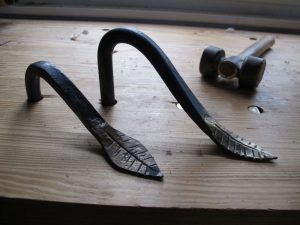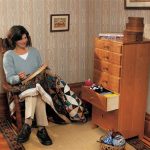We may receive a commission when you use our affiliate links. However, this does not impact our recommendations.
It seems I have more holdfasts than internal organs. And yet, when I was dropping something off at Managing Editor Megan Fitzpatrick’s house this week, I was struck by two holdfasts in her bench that were familiar and yet different – like an old friend who had lost weight or gotten implants.
The holdfasts were made by Alaskan blacksmith Phil Koontz and had been given to Megan as a gift (some women like diamonds, and then there is Megan…). I’ve had a pair of Koontz’s holdfasts since 2004 or so, but these were different.
They had much more of a curve to them than my older holdfasts. It wasn’t subtle. They had so much of a curve that they looked more like a “shepherd’s crook” holdfast than the flatter ones he made before.
Ignoring Megan completely, I began messing around with the holdfasts in her bench, which has a top that is 5” thick or so. The holdfasts stuck like crazy in her bench, and so I asked to borrow them for a couple days so I could compare them to my old ones.
The new holdfasts weigh the same (about 2 lbs. each) as the old ones, have the same reach and about the same shaft length. But the curve makes them stick up about 2” more than his older ones. This design has advantages and disadvantages. The only real disadvantage is that they can occasionally be in the way of your long planes during some operations.
The advantage is that I have found the shepherd’s crook-style holdfasts to be springier and to (in general) hold a bit better. However, any well-made holdfast will do the trick in a wide variety of woods. And by “well made” I mean those made by blacksmiths or Gramercy tools in Brooklyn, New York.
After messing with them a bit, I e-mailed Koontz to get the story on the design change.
After a recent flurry of orders after Woodworking in America, Koontz decided to make some changes to the details of his holdfasts.
“The higher curve was mostly a conscious thing, partly because I have developed more of a taste for how I want them to look, and partly because I have started to use a jig to set the final angle of the pad so it contacts the work a little better. When I did that, I found that I wanted more curve right there by the pad, so the contact point won’t change so much as they set.
“This is hard to explain without graphics, but as you know, holdfasts aren’t perpendicular to the work when they are in use. I make the pad square to the shaft, although some of the old ones weren’t very accurate in that regard. When the holdfasts seat, the contact moves closer to the shaft. The higher curve makes more allowance for that movement. I suppose that’s why so many of the traditional designs had more of a ‘C’ shaped curve. I have also started making the reach a bit longer, and maybe improved the tapers a bit. I think that the main issue with grabbiness is the reach, and that comes back to the contact area on the pad.”
If you are interested in getting a set of handmade holdfasts from Koontz, the best way to reach him to discuss orders and pricing is through his e-mail address: phil.koontz@gmail.com. It’s nice to see someone’s work continue to evolve and improve over the years, even if it does make me feel a bit old.
— Christopher Schwarz
Holdfasts are one of the most important bench accessories. And they are indispensable when using a traditional workbench. My book “Workbenches: From Design & Theory to Construction & Use” discusses how to use these tools at some length is available at a very good price in the ShopWoodworking store.
Here are some supplies and tools we find essential in our everyday work around the shop. We may receive a commission from sales referred by our links; however, we have carefully selected these products for their usefulness and quality.










Chris, I just built your original Roubo workbench from your Workbenches book and I drilled three holes in the top for the Phil Koontz holdfasts. One of the holes works great the other two won’t stick the holdfast when I strike them with a mallet. Do you know how to fix the holes so they can work properly? Also, do you have any recommendation when I drill the new holes? I love the bench and the and the holdfasts.
Chris, Just got my set in the mail today..Thanks for the recommendation. Now I just have to build that Roubo!
Chris,
These are amazing, I went to the website and also saw they are sold out. Does anyone know the cost so I can plan to add them into my studio. Thanks
So Chris,
I just ordered a set of holdfasts from Gramercy Tools for the more traditional workbench that I’ll be making soon. Is there an ideal thickness for the top of my bench for these to work best?
I’ve got one of Phil’s gorgeous holdfasts (i’m assuming the older style) and it is the very embodiment of the William Morris quote:
“Have nothing in your (workshop) that you do not know to be useful, or believe to be beautiful”
Imagine, adults getting excited about a rod of bent iron. It’s crazy, a throw-back to dying crafts, passion before production, and not making a fortune (at least in monetary value). Imagine, it’s all good, nah – the better: salvation of our roots, and that which makes us humble in knowing that far too few have taken this path toward – well, should I say, anarchy?
There’s no URL embedded in the “Workbenches: From Design & Theory to Construction & Use” link.
He makes a nice looking holdfast I am a little surprised he dose not have a WEB page. I am using a set from Gramercy and should be getting a pair from Don Weber (oh boy) in a week or two – if Kentucky is not snowed in.
A lot of things have claimed to change how I worked wood holdfasts really have.
I didn’t get a chance to ask at WIA – Why no mention of holdfasts in The Anarchist’s Tool Chest.
Chris, do you know when Phil made this change? I was shocked when I read the caption and the one on the right is the new version. It looks just like my Koontz holdfasts that I got in late 2008. I even did a review of them alongside several other models (http://www.renaissancewoodworker.com/a-battle-of-holdfasts/) and you can see in the images how the design was changing even “way back then”. I’m sure he has refined them even a bit more but the higher curve and shaped pad are on my versions. I guess the cool part is really that each holdfast is unique. Regardless, they are still awesome after extensive use for the last 4 years.